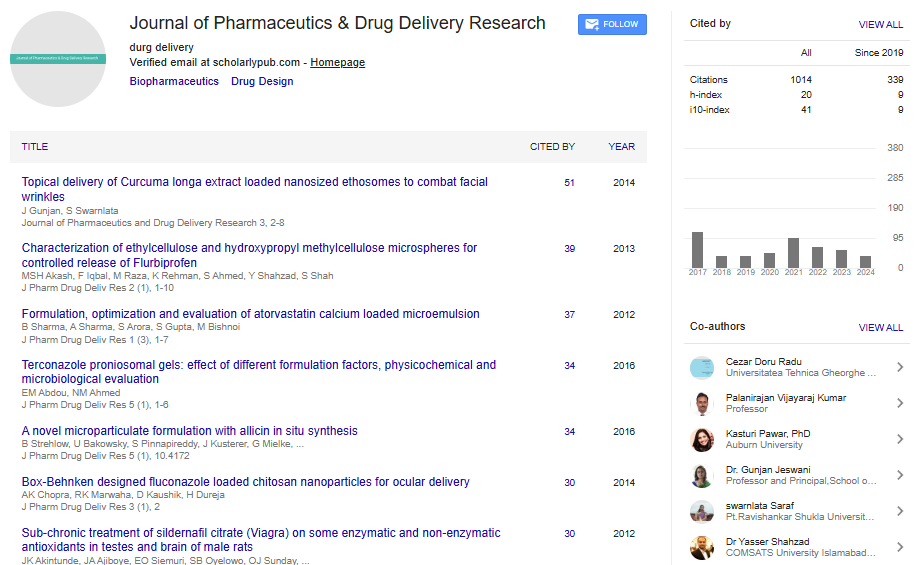Opinion Article, J Pharm Drug Deliv Res Vol: 13 Issue: 4
Enhancing Drug Absorption and Bioavailability via Innovations in Biopharmaceutics
Benedicte Franck*
1Department of Pharmacology, Columbia University, New York, USA
*Corresponding Author: Benedicte Franck,
Department of Pharmacology, Columbia
University, New York, USA
E-mail: franckb68@gmail.com
Received date: 01 July, 2024, Manuscript No. JPDDR-24-145764;
Editor assigned date: 03 July, 2024, PreQC No. JPDDR-24-145764 (PQ);
Reviewed date: 17 July, 2024, QC No. JPDDR-24-145764;
Revised date: 24 July, 2024, Manuscript No. JPDDR-24-145764 (R);
Published date: 31 July, 2024, DOI: 10.4172/2325-9604.1000293
Citation: Franck B, (2024) Enhancing Drug Absorption and Bioavailability via Innovations in Biopharmaceutics. J Pharm Drug Deliv Res 13:4.
Description
Biopharmaceutics is a vital discipline within pharmaceutical sciences that focuses on the interrelationship between the physical and chemical properties of drugs, their dosage forms and the biological effects they produce. By understanding these connections, scientists and clinicians can optimize drug formulations to improve therapeutic outcomes. This field is particularly important in the development of new drugs, where the goal is not only to create effective molecules but also to ensure that these molecules can be delivered to the target site in the body in a safe and efficient manner.
At the heart of biopharmaceutics is the study of drug Absorption, Distribution, Metabolism and Excretion (ADME). These processes determine the bioavailability of a drug, which is a key factor in its effectiveness. Bioavailability refers to the proportion of a drug that enters the bloodstream when introduced into the body and is available to produce its therapeutic effect.
Several factors influence bioavailability, including the drug's solubility, permeability and stability. For instance, a drug that is poorly soluble may not dissolve sufficiently in the gastrointestinal tract, leading to low absorption and reduced bioavailability. Similarly, a drug that is rapidly metabolized by the liver before reaching systemic circulation may also have reduced bioavailability.
Drug formulation is a precarious aspect of biopharmaceutics. The way a drug is formulated can significantly impact its bioavailability and, consequently, its therapeutic effectiveness. For example, the use of different excipients (inactive ingredients) in a tablet can affect the rate at which the drug is released and absorbed. Techniques such as controlled-release formulations are designed to release the drug slowly over time, maintaining therapeutic levels in the bloodstream and reducing the frequency of dosing.
In recent years, advancements in nanotechnology have opened new avenues in drug formulation. Nanoparticles, liposomes and other nanoscale delivery systems can enhance the bioavailability of poorly soluble drugs by improving their solubility and stability. These systems can also target drugs to specific tissues or cells, reducing side effects and improving therapeutic outcomes.
The principles of biopharmaceutics are increasingly being applied in the field of personalized medicine. Personalized medicine aims to tailor treatments to individual patients based on their genetic makeup, lifestyle, and other factors. In this context, biopharmaceutics plays an essential role in optimizing drug formulations and dosing regimens for individual patients.
For instance, genetic variations can affect how a patient metabolizes a drug, leading to differences in drug response. By understanding these variations, clinicians can adjust the drug formulation or dosage to achieve the desired therapeutic effect while minimizing the risk of adverse effects.
Regulatory agencies, such as the U.S. Food and Drug Administration (FDA) and the European Medicines Agency (EMA), place great emphasis on biopharmaceutics during the drug approval process. These agencies require comprehensive studies to demonstrate that a drug's formulation is safe and effective. Biopharmaceutic studies are essential in determining the appropriate dosage forms, strengths and administration routes for new drugs.
One of the key concepts in this area is the Biopharmaceutics Classification System (BCS), which classifies drugs into four categories based on their solubility and permeability. The BCS helps guide the development of drug formulations and regulatory decisions. For example, drugs in BCS Class I (high solubility and high permeability) are generally easier to formulate, as they are likely to be well absorbed. In contrast, drugs in BCS Class IV (low solubility and low permeability) pose significant challenges in formulation and may require innovative delivery systems.
Conclusion
Biopharmaceutics is a dynamic and evolving field that bridges the gap between drug formulation and therapeutic effectiveness. By understanding the complex interactions between a drug's properties, its formulation and the body's biological systems, scientists and clinicians can develop more effective and safer medications. As the field continues to advance, particularly with the integration of nanotechnology and personalized medicine, biopharmaceutics will play an increasingly important role in the future of healthcare.
 Spanish
Spanish  Chinese
Chinese  Russian
Russian  German
German  French
French  Japanese
Japanese  Portuguese
Portuguese  Hindi
Hindi 
